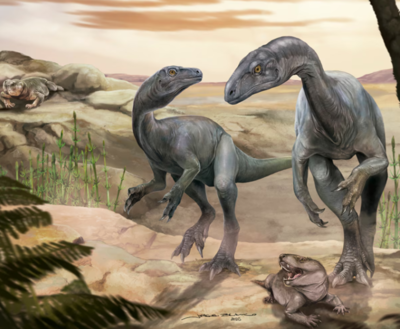ARTICLE AD BOX

A nearly complete fossil of Huayracursor jaguensis, one of the world's oldest dinosaurs, was discovered in Argentina. This new species, dating back 230 million years, reveals early sauropodomorph evolution with its long neck and larger size, challenging previous assumptions about these traits' emergence.
Fossils are a direct source of glimpse into the past, which give a window into the possible living conditions, ecosystem and lifestyle of the living beings from the past. Whenever a new fossil is discovered it is no less than a novel window for yet another scientific discovery.

Huayracursor jaguensis-- Photo: X/ @Dinoh555
Fossil discovery with missing head
Recently a fossil has been discovered, and it is being considered as one of the world's oldest dinosaur fossils has been discovered in a remote region of Argentina, revealing a new species named Huayracursor jaguensis. This dinosaur lived during the Late Triassic period some 230 million years ago and gives exciting new insights into early sauropodomorph evolution, the group of long-necked herbivores that later included giants like Argentinosaurus.
The fossil is almost completely preserved, though notably missing its head, and was found in the challenging terrain of La Rioja province's foothills of the Andes mountains, according to a research published in Nature.
This discovery is one of a kind
According to Martín Hechenleitner, a researcher at the Regional Center for Scientific Research and Technology Transfer of La Rioja, “It’s one of those discoveries that don’t come along often.” The estimate by Agustín Martinelli of the Bernardino Rivadavia Argentine Museum of Natural Sciences places Huayracursor’s age between 230 and 225 million years, making it among the oldest dinosaurs discovered globally.
This fossil is The long necked dinosaur
Huayracursor was a relatively small dinosaur, about two meters (6 feet) long and weighing roughly 18 kilograms (40 pounds), yet it was larger than many contemporaneous species like Bagualasaurus. Its long neck and larger size represent key evolutionary traits that emerged earlier than previously thought. Hechenleitner emphasised, “Huayracursor is novel because it exhibits two key features: a considerably longer neck and a larger size than most of its contemporaries.
These aspects confirm a very early and synchronous appearance of both characteristics, which were fundamental to the evolutionary history of sauropodomorphs.”
A treasure trove of Triassic fossils
The discovery was made possible during the first scientific expedition into a previously unexplored geological basin in La Rioja. Harsh terrain and weather had kept paleontologists from venturing into this region before, but recent efforts have revealed a treasure trove of Triassic fossils.
Martinelli described the excitement, “It’s rare in life that one can say that totally new sites have been discovered, with fauna that are extraordinary in their preservation and abundance.
”Named to honor its windy hometown, Huayracursor combines "huayra," meaning wind in Quechuan, with "cursor," meaning runner, and the species name jaguensis references the nearby village of Jagüé.The research team plans to extend their exploration toward the Andes, hopeful that this find is only the beginning of many more discoveries that will deepen our understanding of dinosaur evolution in Gondwana, the ancient southern supercontinent.

 4 hours ago
4
4 hours ago
4









 English (US) ·
English (US) ·